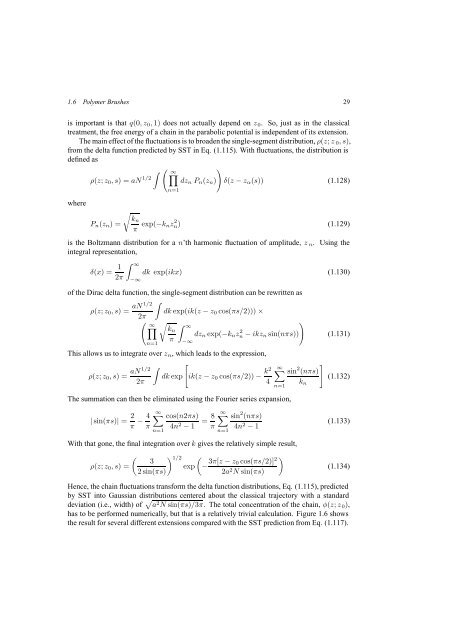Self-Consistent Field Theory and Its Applications by M. W. Matsen
Self-Consistent Field Theory and Its Applications by M. W. Matsen
Self-Consistent Field Theory and Its Applications by M. W. Matsen
You also want an ePaper? Increase the reach of your titles
YUMPU automatically turns print PDFs into web optimized ePapers that Google loves.
1.6 Polymer Brushes 29<br />
is important is that q(0,z 0 , 1) does not actually depend on z 0 . So, just as in the classical<br />
treatment, the free energy of a chain in the parabolic potential is independent of its extension.<br />
The main effect of the fluctuations is to broaden the single-segment distribution, ρ(z; z 0 ,s),<br />
from the delta function predicted <strong>by</strong> SST in Eq. (1.115). With fluctuations, the distribution is<br />
defined as<br />
∫ ( )<br />
∏<br />
∞<br />
ρ(z; z 0 ,s)=aN 1/2 dz n P n (z n ) δ(z − z α (s)) (1.128)<br />
n=1<br />
where<br />
√<br />
kn<br />
P n (z n )=<br />
π exp(−k nzn) 2 (1.129)<br />
is the Boltzmann distribution for a n’th harmonic fluctuation of amplitude, z n . Using the<br />
integral representation,<br />
δ(x) = 1<br />
2π<br />
∫ ∞<br />
−∞<br />
dk exp(ikx) (1.130)<br />
of the Dirac delta function, the single-segment distribution can be rewritten as<br />
1/2<br />
∫<br />
aN<br />
ρ(z; z 0 ,s)= dk exp(ik(z − z 0 cos(πs/2))) ×<br />
2π<br />
(<br />
∏ ∞<br />
√ ∫ )<br />
∞<br />
kn<br />
dz n exp(−k n zn 2 − ikz n sin(nπs)) (1.131)<br />
π<br />
n=1 −∞<br />
This allows us to integrate over z n , which leads to the expression,<br />
1/2<br />
∫ [<br />
]<br />
aN<br />
∞∑<br />
ρ(z; z 0 ,s)= dk exp ik(z − z 0 cos(πs/2)) − k2 sin 2 (nπs)<br />
(1.132)<br />
2π<br />
4 k n<br />
n=1<br />
The summation can then be eliminated using the Fourier series expansion,<br />
| sin(πs)| = 2 π − 4 π<br />
∞∑<br />
n=1<br />
cos(n2πs)<br />
4n 2 − 1<br />
= 8 π<br />
∞∑<br />
n=1<br />
sin 2 (nπs)<br />
4n 2 − 1<br />
(1.133)<br />
With that gone, the final integration over k gives the relatively simple result,<br />
( ) 1/2<br />
3<br />
ρ(z; z 0 ,s)=<br />
exp<br />
(− 3π[z − z 0 cos(πs/2)] 2 )<br />
2sin(πs)<br />
2a 2 N sin(πs)<br />
(1.134)<br />
Hence, the chain fluctuations transform the delta function distributions, Eq. (1.115), predicted<br />
<strong>by</strong> SST into Gaussian distributions centered about the classical trajectory with a st<strong>and</strong>ard<br />
deviation (i.e., width) of √ a 2 N sin(πs)/3π. The total concentration of the chain, φ(z; z 0 ),<br />
has to be performed numerically, but that is a relatively trivial calculation. Figure 1.6 shows<br />
the result for several different extensions compared with the SST prediction from Eq. (1.117).
















